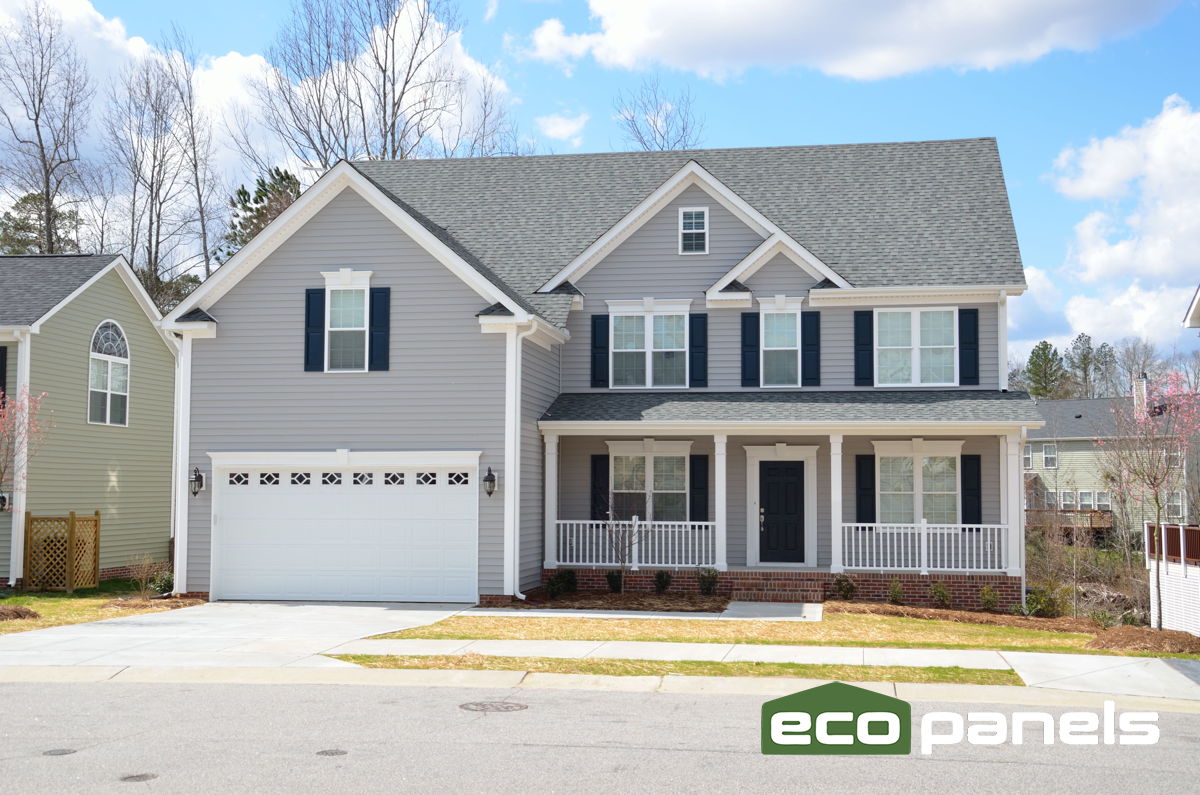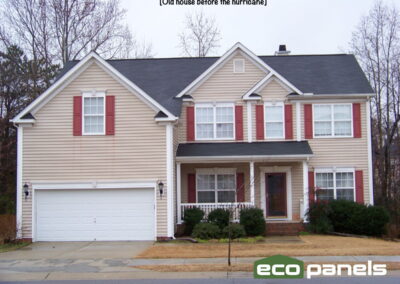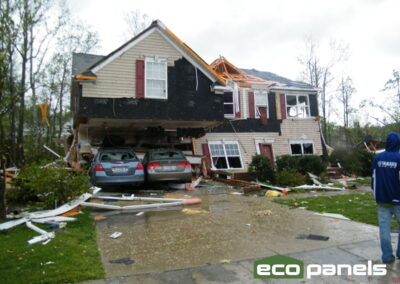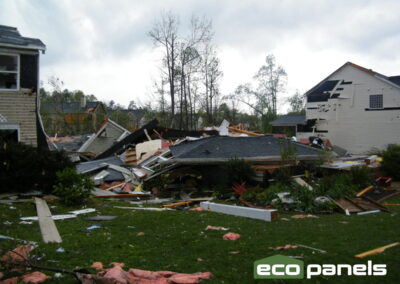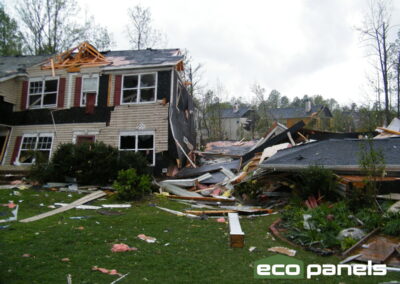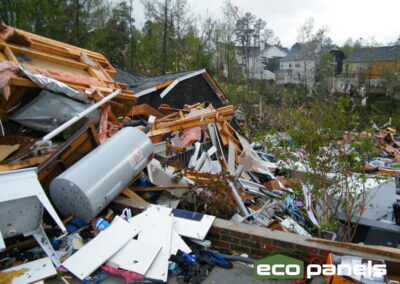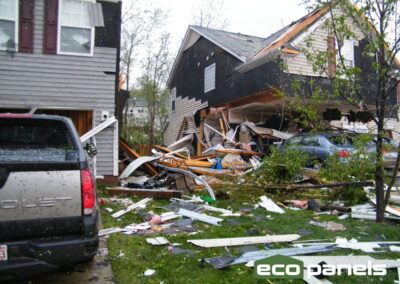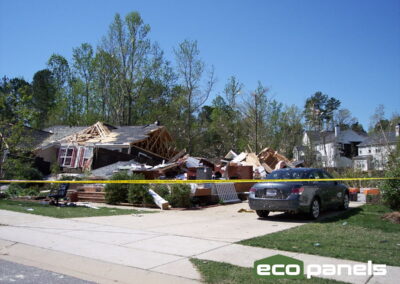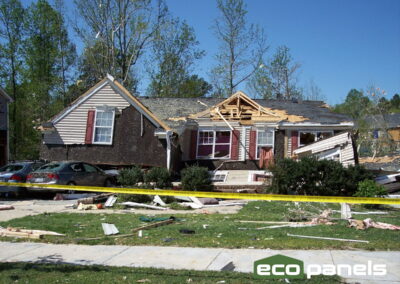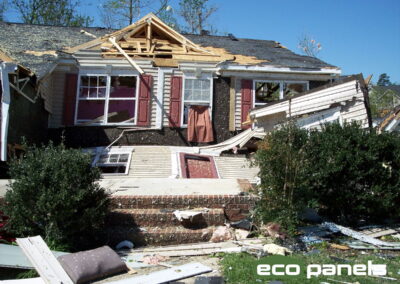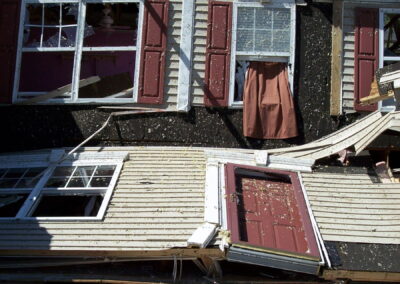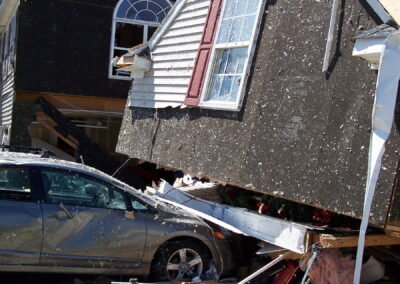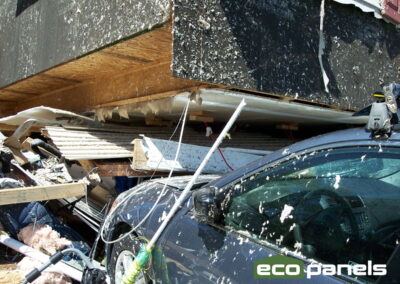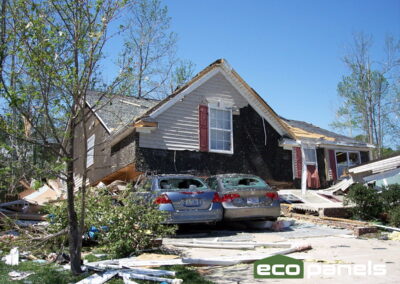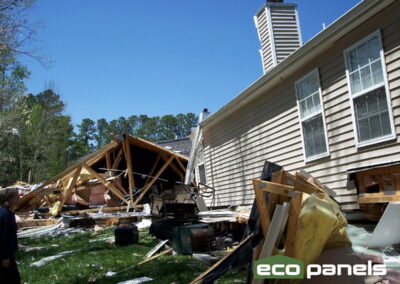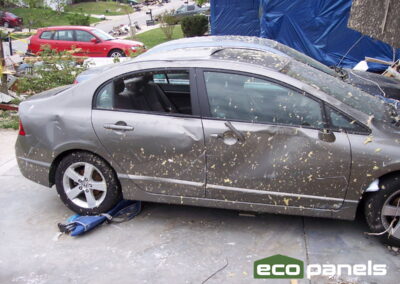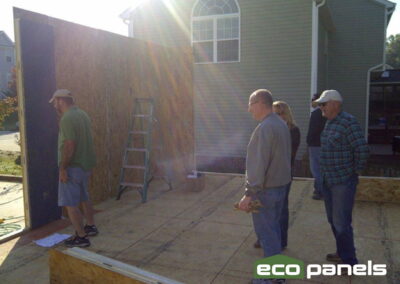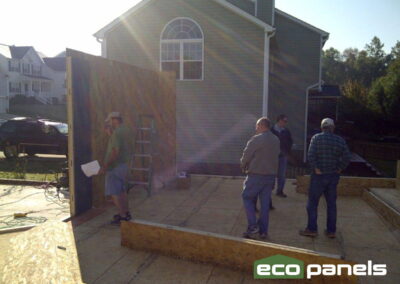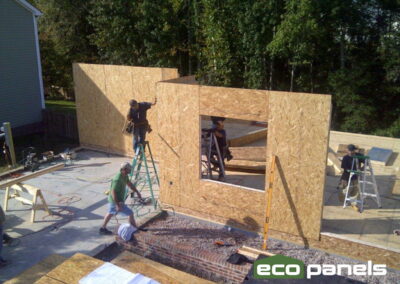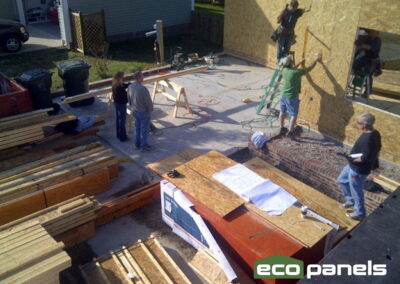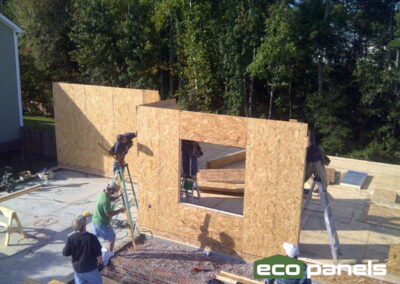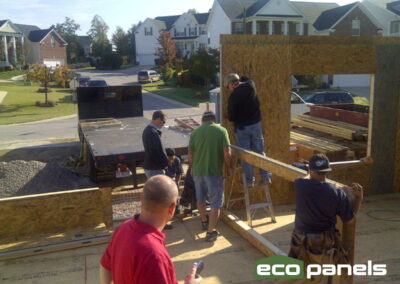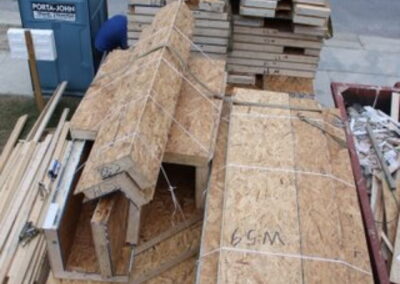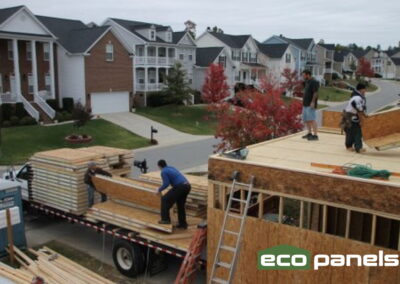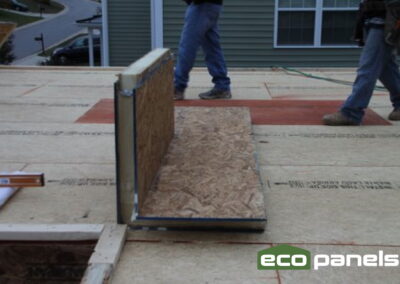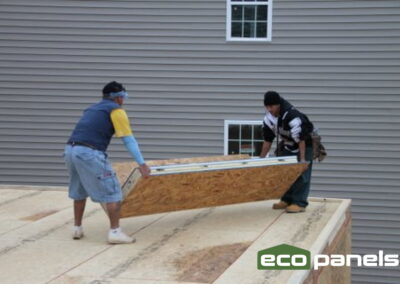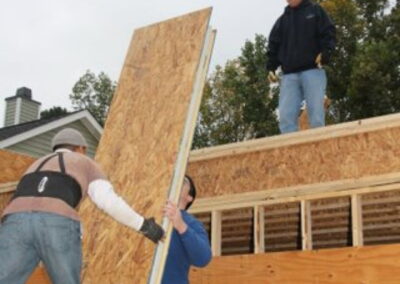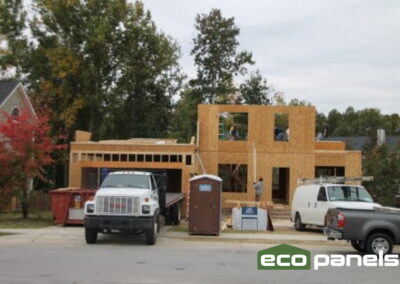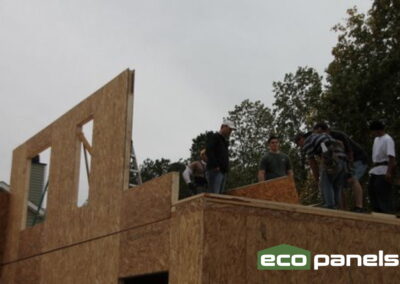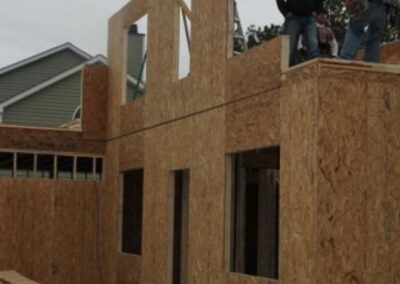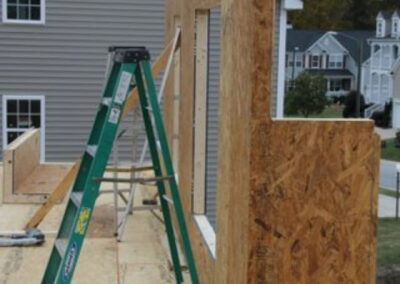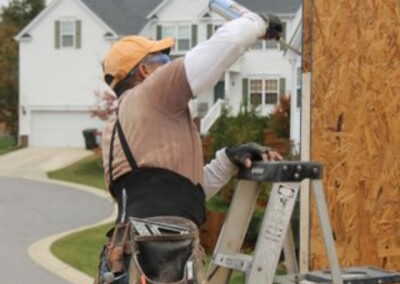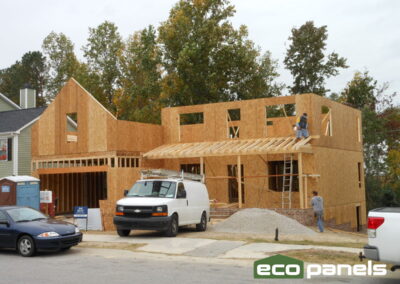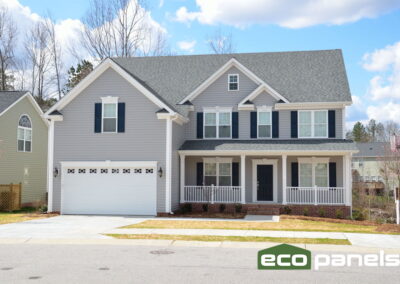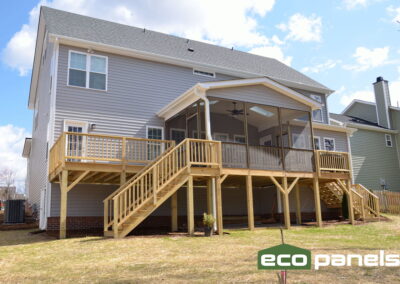J.S. – Raleigh, North Carolina
This gentleman lives in Raleigh, NC, and his home was destroyed by tornadoes that swept through Raleigh in the spring of 2011. We first met “JS” when we were working on our New Orleans project with Brad Pitt’s “Make it Right Foundation” as part of hurricane Katrina reconstruction.
Here are pictures of his destroyed, in-process construction and completed home. The panels for each floor took just several hours to erect. And note the favorable comments about the insurance industry and the damning comments about traditional construction.
Customer Testimonial - Rebuilding After Tornado Destruction
[Early 2013]
Hi Charles – Happy New Year!
Ok. So we did lower our electric, BUT our entire house is conditioned. Our prior home did not have a conditioned attic or crawlspace, and our new house does. (Half of the crawlspace is “Walk-space” if you know what I mean.) Plus, the heat pumps are almost half the size of the units we had before, and we added an ERV. For comparison purposes, our 1st home was destroyed on April 16, 2011, and we moved into our new home on Feb 3, 2012. The Feb 2012 bill is high because we had a lot of “punch list” construction items that required the exterior doors to be off the hinges for awhile (Yeah, we probably moved in too soon, but we were eager to get back home!) … Keep in mind that rates have gone up every year, and our new home has more conditioned space.
Using Eco-Panels makes economic sense in any number of ways. The construction costs for us ended up being a wash. All told it was about the same price, maybe a little more, but not much. It seemed like it cost a little more, but not anywhere near the 7% we talked about. The insurance rebuild meant the money was handled differently, and it exposed all the costs at the end. Our house is very comfortable, and the temps are steady. I imagine as solar technology improves we’ll take advantage of it in the future, and we have an energy efficient house that will make the most of that technology when we implement it.
However, the comfort and efficiency were a bonus. The real reason I wanted to use Eco-Panels was because of the strength and the control of construction. My home was destroyed in the April 16, 2011 tornado outbreak, and the more I learned from the FEMA engineers the more upset I became at how poorly my home was originally constructed despite meeting all local and national construction codes. You can talk with the builder all day long about construction methods, but onsite he’s far disconnected from the carpenter with the nail gun. I also discovered that the insurance industry has taken some strides to promote home and business safety as well, and they are rewarding consumers with lower rates and enhanced coverage for building homes that will withstand greater perils. (Check out www.disastersafety.org) When I told my insurance company I was rebuilding with Eco-Panels they were excited and kept telling us how much more structurally sound the house would be. Yes, our rates fell significantly, but they treated us so well through the disaster that we bought a lot more coverage in other areas to maintain the premium levels we had before [JS told us separately that he was able to about double his insurance coverage for the same monthly premium amount]. At any rate, I liked the idea that the walls were made in a factory under controlled conditions.
The building code creation process is a political process, a tug-of-war between the engineers of the inspection department and the lobbying interests of the home building industry. Both sides make good arguments and try to balance structural safety with keeping home s affordable. I had a pretty traumatic experience in April of 2011, and I set out to build a much stronger home. I investigated a lot of building methods and interviewed a lot of builders. I continually steered the conversation to structural integrity and they said, “We build to code,” and changed the conversation to hardwood floors, crown molding, toilets and countertops. My family was home when our house was destroyed, so you can imagine what we go through when a thunderstorm approaches. “Built to code” isn’t good enough for me anymore. The reason I used Eco-Panels is that my home is significantly stronger than before. The house has a solidity that’s apparent to anyone who walks in, but it’s very hard to describe. My neighbors even joked about me building a fortress! The building inspectors were impressed and kept commenting about how my home far exceeded the structural building code.
Lastly, I think Eco-Panels has the best system out there. Charles has made everything easy to assemble correctly so inexperienced crews can put a home together properly, quickly, and with little training.
So, I got a house that is very efficient, cost about the same to build, and is much stronger than before.
I have a two-story home on a crawl space. The 1st and 2nd floor walls are Eco-Panels. The roof and pony walls of the crawl space are traditional construction.
We used a spray foam for the roof, gable ends, crawl space and banding. (The floor joists sit on top of the walls, and the banding is that space around the edge of the house between the ceiling and the floor above.)
What I’m going to do differently for my next Eco-Panels home:
- Get the electrical contractor more involved in the planning process. I think he would have had an easier time if a few more of the internal electrical runs could have used the outside walls. It wasn’t a big deal, but I think it could have gone better for him. Keep in mind, everyone complained at the beginning at how hard things would be, but when they actually worked with the panels they said it was much easier than anticipated!
- Make sure my architect understands that the pitch of a traditional roof needs to be a little steeper because it must rest on the Eco-Panels walls, not the floor joists. Not a big deal, but w could have used that extra six inches of headroom in a couple of spots in the attic. Actually, I would probably look harder at an Eco-Panels Roof. It would have cost more, but in the end I think it would have been easier.
I hope this helps!
JS
On Fri, Jan 18, 2013 at 6:22 PM JS wrote:
Charles,
Sorry for the ramble.
I’m still trying to express my shock at the building code process.
I think builders should be required to have a conversation with the homeowner about structural integrity and let the homeowner decide how to proceed.
Our house is wonderful. I would build it like this again in a heartbeat.
Please give her my contact information if she wants to speak with me or email me.
You made everything so easy.
JS
On Fri, Jan 18, 2013 at 6:29 PM JS wrote:
Oh – Charles! One last thing:
I would put a bath-type exhaust fan in the laundry room. It gets really hot in there with the dryer running!
JS
On Sat, Jan 19, 2013 at 8:33 AM JS wrote:
Charles,
The cold morning brought some realizations regarding energy usage.
In the old house, we would manage the thermostat pretty regularly. It was rarely set higher than 68 or 69, and our home was rarely comfortable.
Mornings like today heat pump would drone on for hours. Now, we keep the 2nd floor at 70 and the first at 69. The third is kept at 62, but it rarely gets lower than 70 up there, even with the door closed on the 2nd floor. We have no cold spots in the house; even the closet above the garage is comfortable.
I’m realizing how much more efficient the house is. To get a good read on the bills I sent, the house is much bigger, the rates have gone up, and we’re not nearly as careful about the thermostat.
Just wanted to add that last bit…
JS
On Sat, Jan 19, 2013 at 8:38 AM Charles Leahy wrote:
Another question: About how many square feet larger is your home conditioned space today than from it was before?
– Charles
On Sat, Jan 19, 2013 at 11:23 AM JS wrote:
Not as straightforward an answer as you might think…
The total heated space square footage on the plans is 3626 with 125 for storage and the upstairs air handler, and the crawl space is the same as the first floor – 1332.
I think they only count the heated space (vents) with walls that are 4ft or higher. The 125 square feet of storage on the third floor is the only area that doesn’t have a vent in it. It’s separated by drywall – no insulation because the envelope is insulated.
Our previous house was 2980 sq ft, but listed on the deed page as 3068. There were areas on the 2nd floor that were not heated, and even had venting to the elements through the eaves.
The crawl space was vented on all four sides and extended under the front porch. Truth be told, our original floorplan was supposed to be 2880 square feet when we bought the house. I guess they thought my house grew?
So, we went from heating and cooling a 2980 (or 3068 according to the tax records)square foot home to heating and cooling 3751 square feet of space plus the 1332 in the crawl.
That sure puts things in perspective…
I hope this helps.
JS
On Sun, Feb 3, 2013 at 11:53 AM Charles Leahy wrote:
Good morning JS,
Which insurance company do you use that was actually so forward thinking as to consider the construction method of how a home is built?
Best,
Charles
On Sun, Feb 3, 2013 at 12:52 PM JS wrote:
Charles,
We use USAA. I called before we built and had a great conversation with the underwriting department. Using Eco-Panels was outside the rebuild parameters stated in the claim (long story…) and I wanted to make sure we wouldn’t have a problem insuring the house afterward given the builder issues I had. USAA’s underwriting department gave me enthusiastic support, and said SIPS was among the strongest and safest. Then I was told about IBHS.
A group of companies have gotten together to promote “code plus” building standards and they reward consumers with lower rates. The programs are largely in the coastal areas, but the reps are eager to talk. It’s call the Insurance Institute for Business and Home Safety. www.disastersafety.org.
Seems they’re fed up with cleaning up “code” construction messes and took it to market.
I spent time with them and the FEMA engineers and I learned how to make a home safer. The problem is that the builders get the training, not the guys with the nail gun. Something as simple as the angle of the nail gun can be the difference between a house blowing apart or staying together, and the builders rarely, if ever get it right. Walls manufactured with a integrated fastening system made much more sense.
Through all of this, I really sensed a frustration between the engineers from FEMA, building inspectors and the insurance companies on one side and the builders and building lobby on the other. The consumer is out of the picture, and it was very difficult to insert myself. The real reason I went through so many builders before I got to Roman is that I asked questions I got from USAA, IBHS and FEMA and all but Roman failed my quiz!
JS

